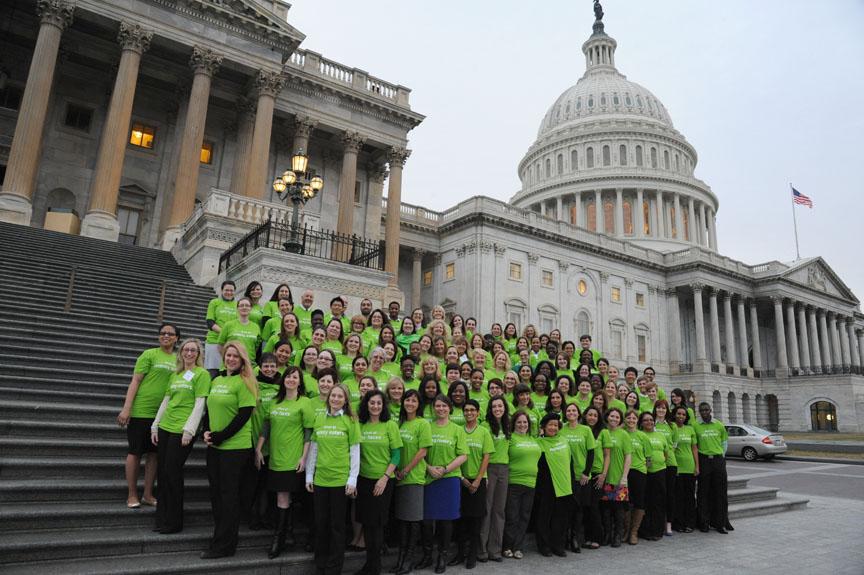
With the Shot@Life Champion Summit in Washington, D.C. quickly approaching, I wanted to offer some insider information to help you prepare for the exciting event. Here are some do’s and don’ts to help you make the most of your summit experience (and avoid some of the mistakes I’ve made in my past three years of Summit attendance).
#1 Do: Remember you are among friends.
While the Summit can seem a bit intimidating, you share a common goal with every one of the 125+ people attending: the desire to make sure children around the globe get access to lifesaving vaccines. That’s a strong connection. Also, these people are really good and interesting folks.
When I walked into the summit for the first time, I knew exactly one other person attending, and her flight was delayed, so I was on my own. People were kind and welcoming. Don’t be afraid to say hello, introduce yourself, and strike up a conversation by asking what drew them to the summit. The number of good friends I’ve made has been an unexpected and wonderful benefit of my summit attendance. Also, as happens when you’re among friends, come prepared to share some laughs. Shot@Life champions advocate for a serious cause, but that doesn’t mean we don’t have fun doing it.
#2 Do: Think about your connection to the cause and be able to summarize that in a few sentences.
Not only will you be sharing with fellow champions why you’re there, but lawmakers and their staffers also want to know why you care about Shot@Life. Be able to succinctly summarize your personal connection. Feel free to practice in front of the mirror, even if it feels a little silly.
#3 Do: Come ready to learn and be inspired.
From scientists to DC insiders to UNF employees, speakers at the Summit are always impressive. Their experience and dedication consistently inspire me. I learn something new and come away with a deeper understanding of the issues thanks to their unique perspective. Each year, I’ve taken the knowledge gained from those sessions and used it in meetings on the Hill.
#4 Do: Know that all your meetings are important.
While member level meetings are always exciting, know that meetings with staffers are impactful as well. Every meeting is a chance to make our message heard and move closer to our goal.
Remember that you are building relationships with staffers. There are two staffers in different offices with whom I’ve met every year of attending the Summit. They’re both delightful individuals. They ask good, insightful questions and I’m confident the answers are shared with the lawmakers. Assume that you’ll be meeting with these people for years to come and handle yourself in a way that makes them look forward to your visit by being professional and respectful.
#5 Do: Keep an open mind and positive thoughts, especially on Capitol Hill.
While you never know exactly how a meeting on Capitol Hill might go, keep an open mind and envision it being successful. Shot@Life and global childhood vaccination programs have bipartisan support and that’s for a variety of reasons, including that the facts, figures, and compelling stories are on our side.
I’m embarrassed to admit that I’ve learned this the hard way. A few years ago, I entered a meeting with a representative whose voting record made me think I would have to work hard to win him over. I was ready with a barrage of facts and figures, armed with counterpoints to all his possible arguments. While doing your homework is always a good thing, my mindset was rather confrontational and not where it should have been.
Imagine my surprise when he walked in, immediately stated his support, and shared stories from his time in Africa where he witnessed first-hand the obstacles to vaccine delivery. I would have been a better advocate — and I would have been less anxious — if I had approached the meeting as a conversation. It’s a mistake I won’t make again.
#6 Do: Say “thank you” – often.
“Thank you” is a powerful phrase. Expressing gratitude for the opportunity to discuss the cause and Shot@Life’s funding requests is always a good idea, both in person and after the meeting. Saying thank you via social media and tagging the lawmakers is a particularly effective approach.
#7 Do: Power up.
To send those social media thank yous and take photos and make notes on any needed follow up, you’ll want your phone to be fully charged. Definitely start the day with it charged, and bring an additional source of power for your phone, like a power bank or portable charger.
#8 Do: Wear comfortable shoes for Hill Day.
This is another one filed under “lessons I’ve learned the hard way and want to prevent others from making.” While it seems obvious, allow me to implore you to test out your shoes prior to Hill Day. I thought my shoes would be comfortable. Ten thousand steps later, I knew how very wrong I had been.
The following year, I brought some walking shoes to wear in between meetings and could quickly slip on more professional footwear before heading into a meeting. My smile in those photos is a bit bigger than in the prior year’s photos.
#9 Do: Pack your patience.
Whenever you have 125+ people doing anything, you may have to wait a bit. And whenever you are entering a federal building, you have to wait a bit. Fear not, you will get to use the bathroom, you won’t go hungry, and you will get through security at the entrance of every House and Senate office building. It may take a little time, but it will happen. Be patient. Time spent in line can be an opportunity to make new friends, review your talking points, or just take a few deep breaths.
#1 Don’t: Feel like you have to know everything or have all the answers.
The making and delivery of vaccines are complicated, as is the process of lawmaking. The landscape of both is ever-changing. You are not expected to know everything. Champions who have been attending the summit for years are still learning.
If you get asked a question on Hill Day that you don’t know the answer to, don’t panic. It’s perfectly fine to say, “I’m not sure, but I’ll get back to you on that.” Look at it as an opportunity to continue the conversation, further the relationship, and establish yourself as a trusted source for that individual.
Similarly, when prepping with your Hill Day group or planning actions for when you return home, ask questions. Chances are, you’re not the only one wondering. Everyone wants to make sure you have the information you need to be an effective advocate.

